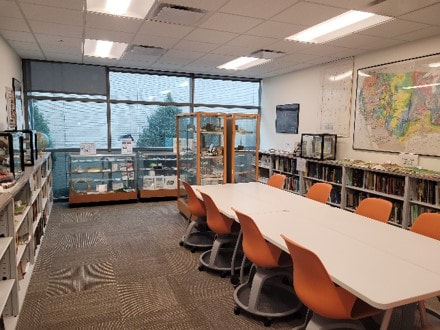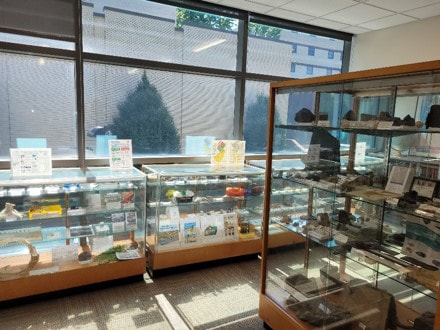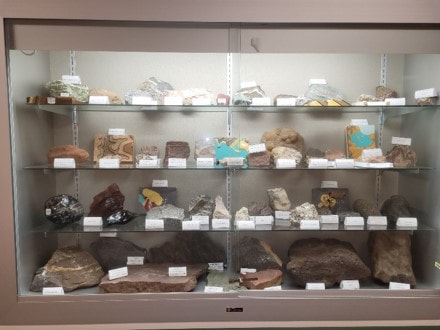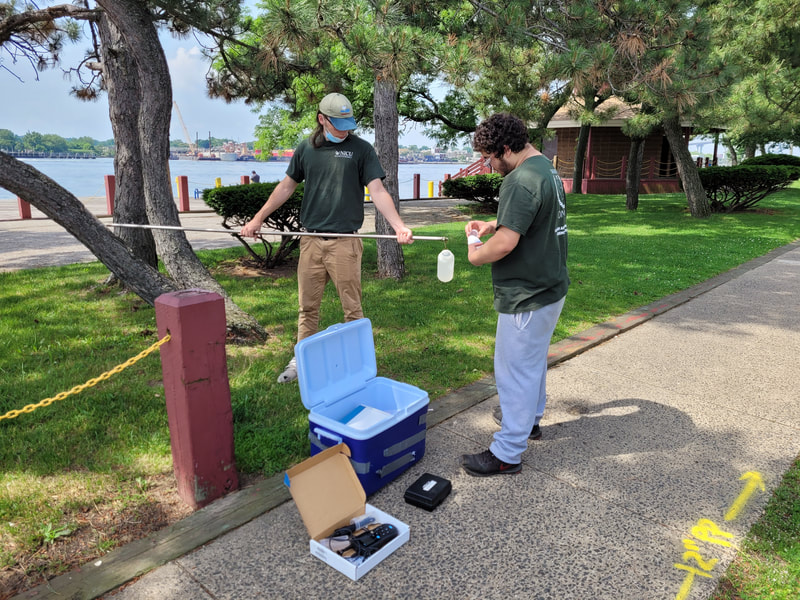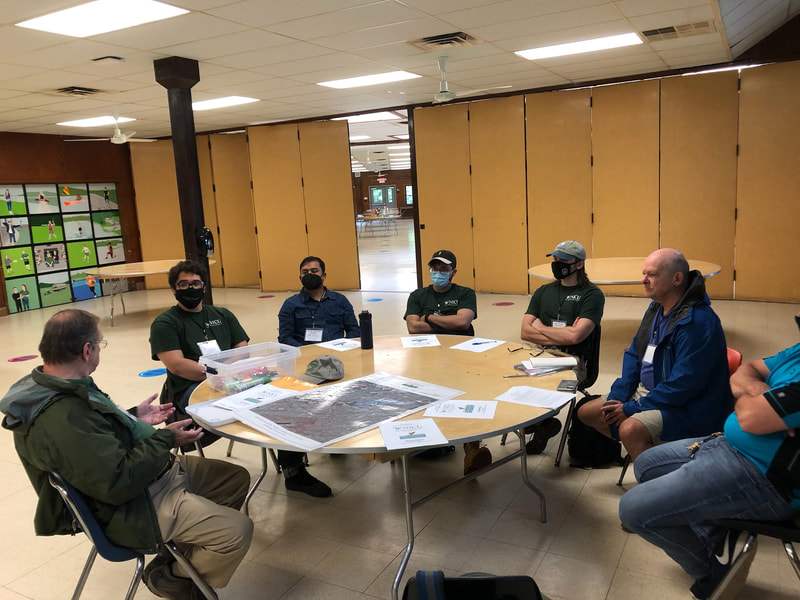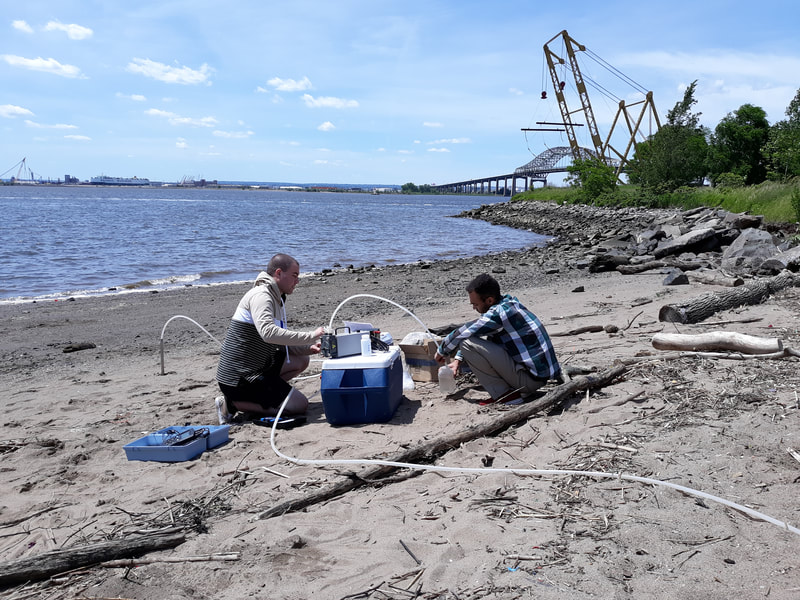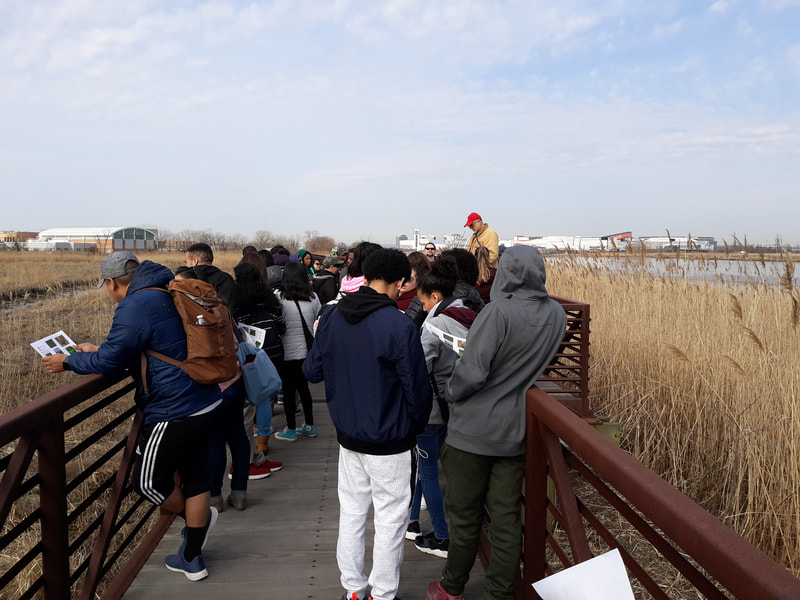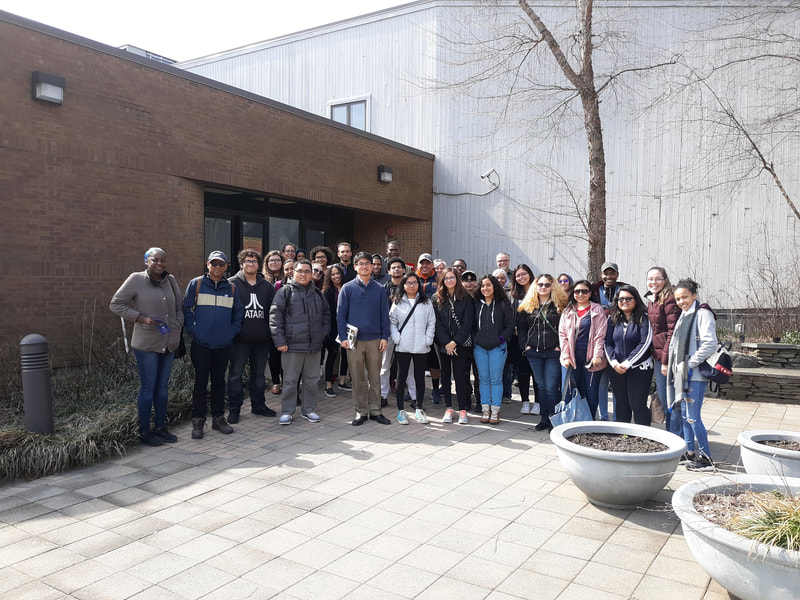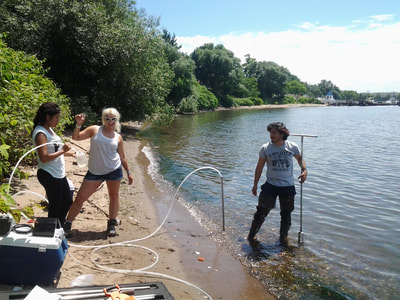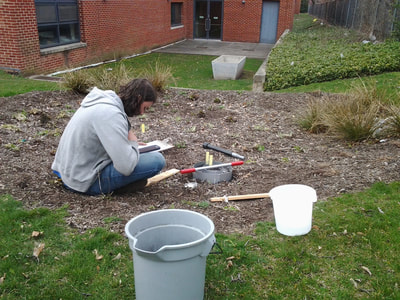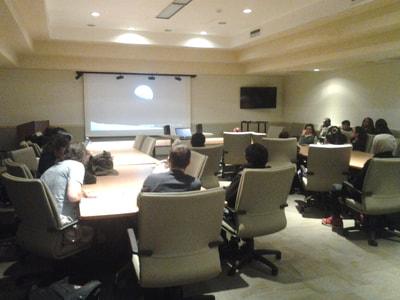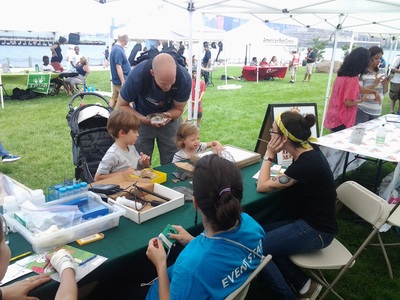Caitlin Carney and Heejin Bae who are Earth & Environmental Sciences majors at NJCU conducted undergraduate summer research projects under the supervision of Dr. Jung from May to July 2022. The research projects focused on water quality of urban estuaries including the Hackensack River, the Passaic River, the Elizabeth River, the Newark Bay and the Upper New York Bay as well as soil infiltration in Jersey City's public parks. Students conducted field and lab investigation for water quality monitoring and also performed soil infiltration tests using a double-ring infiltrometer in the field. The summer research internships were supported by the U.S. Department of Education’s Hispanic-Serving Institutions - Science, Technology, Engineering, or Mathematics and Articulation (HSI-STEM) Program. The students gave poster presentations on their research at the end of the internship.
Dr. Hun Bok Jung gave a webinar presentation entitled "Climate Change: Implications for Global Security" on January 21, 2022 for NJCU International Virtual Exchange Program. The webinar presentation video is available here.
The GIS (Geographic Information System) Day was celebrated at New Jersey City University in the Gilligan Student Union Building on November 17, 2021. GIS Day celebrations began to take place across the globe since 1999 and this was the first celebration of GIS Day at NJCU.
The event was organized by Earth and Environmental Sciences department and the NJCU GIS Day organizing committee consisting of faculty from multiple departments including Dr. Virginia Ochoa-Winemiller, Dr. EunSu Lee, Dr. William Montgomery, Dr. Md Shahinoor Rahman, and Dr. Hun Bok Jung.
The event included oral presentations by a keynote speaker (Dr. Joseph Kerski from Esri), NJCU faculty (Dr. Lee, Dr. Ochoa-Winemiller, and Dr. Montgomery) and Jason Gowers from American Red Cross as well as poster presentations by NJCU students and faculty. The oral and poster presentations covered multi-disciplinary topics including climate change, crime, health, business, water pollution, transportation, natural disasters, education, and sports. A total of 11 students participated in the student poster competition and 4 students were awarded, including Lorianne Andrades (1st place; Health Sciences), Jonathan Rodriguez (2nd place; Earth & Environmental Sciences), Alex Rodriguez (3rd place; Earth & Environmental Sciences), and Zuleika Coplin (LATI Center Best Poster Award; Health Sciences).
The event had about 70 attendees including 40 attendees in person and 30 attendees on Zoom. This event was supported by the Provost's Office, the CAS Dean's Office, LATI Center, School of Business, and Esri.
Additional information about the NJCU GIS Day event can be found from the following links.
NJCU GIS Day event website: https://www.njcu.edu/academics/schools-colleges/william-j-maxwell-college-arts-sciences/departments/earth-environmental-sciences/njcu-gis-day-event
NJCU GIS Day 2021 Proceeding: https://sites.google.com/view/njcuscm/news/2021-njcu-gis-day
Video clips of oral presentations: https://www.youtube.com/channel/UCn7K4QMHIsnpUOz0KiBOd1Q
The event was organized by Earth and Environmental Sciences department and the NJCU GIS Day organizing committee consisting of faculty from multiple departments including Dr. Virginia Ochoa-Winemiller, Dr. EunSu Lee, Dr. William Montgomery, Dr. Md Shahinoor Rahman, and Dr. Hun Bok Jung.
The event included oral presentations by a keynote speaker (Dr. Joseph Kerski from Esri), NJCU faculty (Dr. Lee, Dr. Ochoa-Winemiller, and Dr. Montgomery) and Jason Gowers from American Red Cross as well as poster presentations by NJCU students and faculty. The oral and poster presentations covered multi-disciplinary topics including climate change, crime, health, business, water pollution, transportation, natural disasters, education, and sports. A total of 11 students participated in the student poster competition and 4 students were awarded, including Lorianne Andrades (1st place; Health Sciences), Jonathan Rodriguez (2nd place; Earth & Environmental Sciences), Alex Rodriguez (3rd place; Earth & Environmental Sciences), and Zuleika Coplin (LATI Center Best Poster Award; Health Sciences).
The event had about 70 attendees including 40 attendees in person and 30 attendees on Zoom. This event was supported by the Provost's Office, the CAS Dean's Office, LATI Center, School of Business, and Esri.
Additional information about the NJCU GIS Day event can be found from the following links.
NJCU GIS Day event website: https://www.njcu.edu/academics/schools-colleges/william-j-maxwell-college-arts-sciences/departments/earth-environmental-sciences/njcu-gis-day-event
NJCU GIS Day 2021 Proceeding: https://sites.google.com/view/njcuscm/news/2021-njcu-gis-day
Video clips of oral presentations: https://www.youtube.com/channel/UCn7K4QMHIsnpUOz0KiBOd1Q
The Department of Earth and Environmental Sciences has opened a new museum called NJCU Earth Museum on the second floor of the Science Building. This museum will serve NJCU students, staff, and faculty as well as local community including K-12 schools by providing an educational opportunity to explore the history and environment of Earth through various displays and exhibits of minerals, rocks, fossils and other earth materials. The museum will also show science documentaries and Hollywood movies on natural disasters, environmental pollutions, sustainability and global climate change. The museum is open from 9 AM to 4 PM Mondays through Fridays. Guided tours of the museum will be available upon appointment.
A new YouTube channel for the NJCU Earth & Environmental Sciences was created:
https://www.youtube.com/channel/UCn7K4QMHIsnpUOz0KiBOd1Q
This channel will share videos about education and research in Earth and Environmental Sciences at NJCU, as well as general videos about Earth and the environment.
https://www.youtube.com/channel/UCn7K4QMHIsnpUOz0KiBOd1Q
This channel will share videos about education and research in Earth and Environmental Sciences at NJCU, as well as general videos about Earth and the environment.
From May to July, 2021, three NJCU undergraduate students, Collin Canaley, Alex Rodriguez, and Jonathan Rodriguez participated in summer research projects under the supervision of Dr. Jung and Dr. Rahman. Dr. Jung's research projects focused on surface water and groundwater quality of urban estuaries as well as drinking water quality in public parks within the New York-New Jersey metro area, while Dr. Rahman's project investigated potential pollution sources for algal blooms in Fairview Lake in northwestern New Jersey by GIS mapping and water quality analyses of Fairview Lake inflow streams. The summer research internships were supported by the U.S. Department of Education’s Hispanic-Serving Institutions - Science, Technology, Engineering, or Mathematics and Articulation (HSI-STEM) Program. The students conducted field investigation and laboratory experiments, and gave poster presentations.
On November 13, 2019, the Robotics Team of about 10 students from Frank R. Conwell Middle School - M.S. 4 in Jersey City visited Earth and Environmental Sciences Department at NJCU. Students and their coach consulted with Dr. Jung regarding the development of an environmental research project focusing on urban wastewater treatment and environmental remediation. Dr. Jung and students discussed combined sewer overflows, wastewater treatment plants, and restoration of wetlands.
From May to July, 2019, two NJCU Geoscience majors (Jake Severini and Emaje Hall) participated in environmental research projects focusing on hexavalent chromium removal by natural sediment of the Newark Bay Estuary and surface water and groundwater quality in the Newark Bay Estuary. The summer research internships were supported by the U.S. Department of Education’s Minority Science and Engineering Improvement Program (MSEIP) and Hispanic-Serving Institutions - Science, Technology, Engineering, or Mathematics and Articulation (HSI-STEM) Program. Students conducted field investigation and laboratory experiments to understand critical environmental problems and issues in the New York City metro area. Students gave a poster presentation or produced a final report.
On March 30, 2019, about 30 NJCU students enrolled in Environmental Science for All, Urban Environmental Issues and Policy, and Hydrology courses participated in a field trip guided by the Meadowlands Environmental Research Institute (MERI). Students visited a wetland restoration site located along the Hackensack River, the Meadowlands Environmental Center and a closed landfill site, and learned about various environmental and sustainability issues in urban NY-NJ metro area.
On May to August, 2018, two NJCU Geoscience majors (Jena Richards and Xavier Encalada) and one Union City High School student (Johana Aguilar) participated in summer research projects on temporal and spatial variations of water quality in urban estuaries of New Jersey, transport of nutrients from coastal aquifers to the Newark Bay, and removal of hexavalent chromium by natural sediments of the Newark Bay Estuary. Projects were supported by the U.S. Department of Education’s Minority Science and Engineering Improvement Program (MSEIP) and Hispanic-Serving Institutions - Science, Technology, Engineering, or Mathematics and Articulation (HSI-STEM) Program as well as the ACS Project SEED summer research program. Johana presented her research in Presidential Symposium in the ACS 256th National Meeting held in Boston, MA.
The Department of Earth and Environmental Sciences at NJCU is conducting the monitoring of a rain garden located next to the Visual Art Building on NJCU campus using a double ring infiltrometer to understand the capacity of the rain garden to reduce stormwater runoff. Jesse Lowe, a Geoscience major is involved in the project as a part of his Independent Study under the supervision of Dr. Jung.
NJCU celebrated the 2018 Earth Day event in Vodra Hall on April 17. The event included viewing Al Gore's new movie "An Inconvenient Sequel: Truth to Power", Faculty & Student Panel Discussion, and an invited talk entitled "Microplastic Pollution in the NY-NJ Harbor Estuary" by Sandra Meola (Communications and Outreach Director of NY/NJ Baykeeper Research, Advocacy, and Education). About 50 students as well as several faculty members attended the event. The event was organized by Dr. Jung as well as Dr. Fitzgerald and Dr. Bendaoud.
A manuscript entitled "Nutrients and Heavy Metals Contamination in an Urban Estuary of Northern New Jersey" was published in Geosciences (Switzerland) in October, 2017. This paper focused on impacts of human activities on nutrients and heavy metals in water and sediments of Newark Bay Estuary.
Another manuscript entitled "Water Quality Monitoring of an Urban Estuary and a Coastal Aquifer Using Field Kits and Meters: A Community-Based Environmental Research Project” was published in Journal of Chemical Education (Impact factor = 1.419) in September, 2017. This paper focused on community based environmental research of water quality monitoring for an urban estuary and coastal groundwater by NJCU undergraduate summer research interns who were supported by NSF’s GS-LSAMP grant. The environmental research project can be implemented in various undergraduate STEM courses to facilitate inquiry-driven learning and connect classroom learning to the real world.
Another manuscript entitled "Water Quality Monitoring of an Urban Estuary and a Coastal Aquifer Using Field Kits and Meters: A Community-Based Environmental Research Project” was published in Journal of Chemical Education (Impact factor = 1.419) in September, 2017. This paper focused on community based environmental research of water quality monitoring for an urban estuary and coastal groundwater by NJCU undergraduate summer research interns who were supported by NSF’s GS-LSAMP grant. The environmental research project can be implemented in various undergraduate STEM courses to facilitate inquiry-driven learning and connect classroom learning to the real world.
From June to August 2017, two NJCU undergraduate students (Vuyani Wayne Ntonga and Xavier Encalada) majoring in Geoscience and one Union City High School student (Jessie Yeung) conducted research on biogeochemistry of nutrients and heavy metals in the Newark Bay Estuary of New Jersey. Students were supported by the U.S. Department of Education’s Minority Science and Engineering Improvement Program (MSEIP) and the ACS Project SEED summer research program. Jessie Yeung received second place in the 31st Annual High School Poster Session at Seton Hall University in September 2017. Congratulations!
Students also made soil infiltration measurements using a double-ring infiltrometer in the future site for a rain garden near the NJCU Visual Arts Building, which is one type of green infrastructure to reduce and treat stormwater in urban environments.
Students also made soil infiltration measurements using a double-ring infiltrometer in the future site for a rain garden near the NJCU Visual Arts Building, which is one type of green infrastructure to reduce and treat stormwater in urban environments.
The 8th Annual GS-LSAMP/NNJ-B2B STEM Research Conference was held on October 7, 2016 at Rutgers University-New Brunswick. Loraine Mendez and Luis Aguayo from Hudson County Community College presented two posters entitled "Human Impacts on Biogeochemical Cycling of Nutrients in an Urban Estuary of Northern New Jersey" and "Heavy Metal Contamination in the Sediments of the Passaic and Hackensack Rivers".
In June-August, 2016, Dr. Hun Bok Jung conducted research on Biogeochemical Cycling of Nutrients and Heavy Metals in Urban Estuaries of New Jersey with one NJCU student (Kaylee Saltos) and three HCCC students (Loraine Mendez, Luis Aguayo, and Christina Rodriguez). Students were supported by NSF's Garden State Louis Stokes Alliances for Minority Participation (GS-LSAMP) program, as well as Bridges to the Baccalaureate (B2B) program. Students collected water and sediment samples from rivers, and measured water quality parameters in the field. Students also performed chemical analyses and experiments in the laboratory.
Dr. Hun Bok Jung attended the 2016 Helmsley/National Academies Summer Institute on Undergraduate Education that was held on June 12-16, 2016 at the University of Connecticut. Dr. Jung has been named a National Academies Education Fellow in Science (2016-2017).
Dr. Jung attended the workshop for Early Career Geoscience Faculty held on July 24-28, 2016 at University of Maryland. The topics of the workshop included effective teaching strategies, course design, establishing a research program in a new setting, working with research students, balancing professional and personal responsibilities, and time management.
Dr. Jung attended the 252nd American Chemical Society National Meeting & Exposition at Philadelphia, PA. Dr. Jung gave a poster presentation entitled "Nanoporous goethite controlling the mobility of uranium in saprolite subsoil: Long-term sorption and desorption experiments" on August 24.
Dr. Jung attended the workshop for Early Career Geoscience Faculty held on July 24-28, 2016 at University of Maryland. The topics of the workshop included effective teaching strategies, course design, establishing a research program in a new setting, working with research students, balancing professional and personal responsibilities, and time management.
Dr. Jung attended the 252nd American Chemical Society National Meeting & Exposition at Philadelphia, PA. Dr. Jung gave a poster presentation entitled "Nanoporous goethite controlling the mobility of uranium in saprolite subsoil: Long-term sorption and desorption experiments" on August 24.
A poster entitled “GIS applications for water quality of urban rivers in New Jersey and hydrologic properties of urban coastal aquifers in Staten Island, New York” was presented by Carlohugo Rivera in the 7th Annual GS-LSAMP STEM Research Conference at Rutgers University on October 9, 2015.
Two posters entitled “Submarine Groundwater Discharge of Nutrients from Urban Coastal Aquifers in New York City” and “Water and Sediment Quality of Urban Rivers in New Jersey” were presented in 2015 Geological Society of America Annual Meeting in Baltimore on November 2, 2015. A total of three NJCU students (Felix Zamora, Jordann McAlinden, and Carlohugo Rivera) attended the meeting and presented posters.
Two posters entitled “Submarine Groundwater Discharge of Nutrients from Urban Coastal Aquifers in New York City” and “Water and Sediment Quality of Urban Rivers in New Jersey” were presented in 2015 Geological Society of America Annual Meeting in Baltimore on November 2, 2015. A total of three NJCU students (Felix Zamora, Jordann McAlinden, and Carlohugo Rivera) attended the meeting and presented posters.
NJCU Geoscience & Geography Department was invited to the 2015 City of Water Day event at Maxwell Place Park in Hoboken, New Jersey. Dr. Jung and Geoscience students (Felix Zamora, Jordann McAlinden, and Diana Mejia) displayed fossils and rocks, and demonstrated water quality measurements to the public. We also presented water quality data collected from the Passaic River and Hackensack River, and introduced NJCU and Geoscience & Geography Department to the public.
In Summer 2015, field investigation and laboratory experiments were conducted with the summer research intern students, including Felix Zamora, Jordann McAlinden, Diana Mejia, Jasmine Bryant, and Carlohugo Rivera who were supported by the National Science Foundation Louis Stokes Alliance for Minority Participation in Science (LSAMP) grant and US Department of Education Title V HSI-STEM grant. Two summer research projects were carried out. One project focused on water and sediment quality of urban rivers in New Jersey such as Passaic River and Hackensack River. The objective was to assess the water and sediment quality of urban rivers affected by industrialization and urbanization in the New York and New Jersey metropolitan area. The second project focused on submarine groundwater discharge from coastal aquifers of Staten Island, NY. The objective was to understand the geochemical and hydrological processes of submarine groundwater discharge transporting nutrients from urban coastal aquifers to the ocean.
In April 2015, Dr. Jung's new paper entitled “Stimuli-responsive/rheoreversible hydraulic fracturing fluids as a greener alternative to support geothermal and fossil energy production” was published in Green Chemistry (Royal Society of Chemistry; Impact factor = 8.02).
A new environmentally friendly hydraulic fracturing fluid was developed using CO2 and a polymer solution. This fracturing fluid can effectively create fractures in rocks under geothermal temperature and pressure conditions by volume expansion and viscosity increase.
This study has been highlighted by media. Please take a look at the following links.
http://www.scientificamerican.com/article/greener-fracking-tech-reduces-injection-of-lots-of-wasteful-fluid/
http://phys.org/news/2015-04-fluid-untapped-geothermal-energy-cleaner.html
http://www.eurekalert.org/pub_releases/2015-04/dnnl-phn041515.php
http://www.pnnl.gov/news/release.aspx?id=4195
A new environmentally friendly hydraulic fracturing fluid was developed using CO2 and a polymer solution. This fracturing fluid can effectively create fractures in rocks under geothermal temperature and pressure conditions by volume expansion and viscosity increase.
This study has been highlighted by media. Please take a look at the following links.
http://www.scientificamerican.com/article/greener-fracking-tech-reduces-injection-of-lots-of-wasteful-fluid/
http://phys.org/news/2015-04-fluid-untapped-geothermal-energy-cleaner.html
http://www.eurekalert.org/pub_releases/2015-04/dnnl-phn041515.php
http://www.pnnl.gov/news/release.aspx?id=4195
NJCU Hydrology class went on a field trip to a beach in Great Kills Park in Staten Island, NY on April 10, 2015.
We collected pore water groundwater samples and seawater, and measured the pH and EC of water samples.
We also collected subsurface sediment samples for permeability measurements in the lab.
We collected pore water groundwater samples and seawater, and measured the pH and EC of water samples.
We also collected subsurface sediment samples for permeability measurements in the lab.












